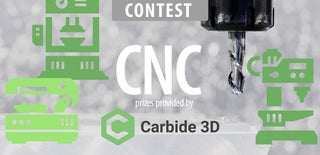Introduction: DIY CNC for Less of 160€ With Arduino
Hi everyone.
I consider that CNC machines are useful tools which allow you to make high precision things that handmade would be way difficult. So a year ago, my father and I started this project in order to built a CNC as cheaper as possible, also with enough precision to "print" a PCB. This is the result.
It've been developed with simple electrical tools, i think the most complex instrument I used was a pillar drill.
This machine is based on Arduino with GRBL firmware and it's compatible with Easel, an awesome tool from Inventables that let you design easily and fast a project for CNC.
So let's get started.
Step 1: Bill of Material
I've bought most of the things in Banggood. Although you can find the same materials with a lower price on another places on the internet, like Ebay.
- T8 200m Lead Screw and Brass Nut
- T8 300m Lead Screw and Brass Nut
- T8 400m Lead Screw and Brass Nut
- Flange Bearing T8 x2
- Linear Motion Ball Bearing x12
- Lineal Bearing for Z axis
- Flexible Shaft Coupling
- Nema 17 Motor x3
- Arduino Nano
- Driver A4988
- 1m Threadedrod T8
- 8 T8 nuts
- 1500mm*1500mm MDF 10mm
- Wires
- Screws
You might also find in the Excel file more detailes about the billl: the quantity of things, or some kind of especification.
In the first photo, you can see four Lead Screw, but finally it's only neccesary three.
In this project, the shield that i used it's a own design, I explain later, in the electrical step but if you don't have experience making PCB, I recommend you to buy a shield compatible with GRBL like this one:
Step 2: BluePrint
These blueprints can be opened with Autocad or any DWG viewer.
The first file is a 2D blueprint of MDF parts of the machine which shows the distance beetween the drill holes. All the drill holes are 8 mm diametre.
The second file is a 3D model of the machine. In order to know where is the parts.
Step 3: Building
I've uploaded a few images of the building process. I recommend constructing it in the order that the images appear, Due to the fact that I think it's the easiest way to build it.
In the blueprints I didn't show any screw holes, because after I built it, I thought it was better to use hot glue or Pattex Power Lijm than glue bearings to the structure.
I believe it's a better way, because it's easier to use and the structure goes to their natural place.
Step 4: Shield ,wires and Motors
In this machine, I have put a shield that I designed by myself. It has some special features like a port for heigh probe and cooler. But also you can buy a commercial one, just like I've put on the bill of materials.
The only necessary:
- Arduino(Uno or Nano ).
- 3 Drivers A4988.
- 3 Motors Nema 17
- 12v 5A voltage supply(the machine needs around 2.5A
- A lot of wire.(well around 5 mtr will be enough)
Basically, the wire connection is like in the diagram from the last imagen but with three motors.
I recommend using tubes for wire and clips to have organised the wires, because sometimes It can be a little difficult to know where does the wires come from.
Attachments
Step 5: Configuration.
GRBL is a firmware developed for the community and It's quite easy to use and upload t. I use GRBL 0.9i but there are newer versions
This is a quite good tutorial Use GRBL Arduino.
Or you can see the videos that there are in Spanish, but it's easily understandable.
Once you have finished the configuration for this machine, you should configurate the parametres of the file.
Attachments
Step 6: Software to Use
Once everything it's ok, it's time to do something but you will need some software.
I used basically two software.
Universal GCodeSender(Stable version Better): This is a free-Software that permits you:
- Manual Control
- Compatible with GRBL
- Use G-Code.
- G-Code Viewer.
- Special funtion as cooler, height probe.
- High Frequency of updates
Easel:A inventable tool for design and "print" projects.
- Easy to use.
- Compatible with GRBL
- Let you design in the app
- Frequently update
- A lot of tools for design special things like boxes, puzzle...
- Internet needed
Step 7: Results
At the end, I'll show you some finish projects that have been done with this machine.
(In order of photograh)
- PCB
- Elevator for laptop
- A gift for my dog
- A mix of things
And a few videos while it's working.
That's all, I hope you like this project if you have any question, please ask.
If you like this instructable please VOTE FOR CNC CARBIDE CONTEST

Participated in the
Epilog Contest 8

Participated in the
CNC Contest 2016

Participated in the
Arduino Contest 2016














